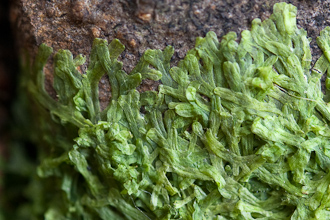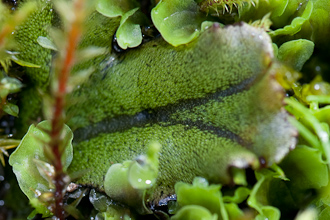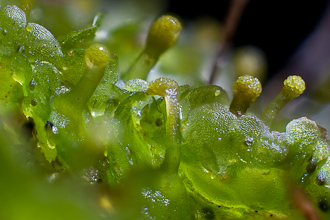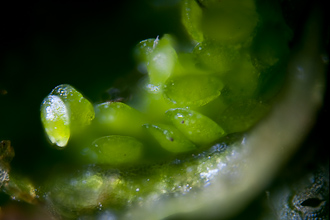
Liverwort characters
Thalloid plant body
Character menu
The character categories and their possible forms are:
-
Thalloid plant body
-
Plant growth habit
-
Arrangement of the leaves
-
Distichous
Distichous:
With two rows of leaves in one plane. - Three rows of leaves
-
Transverse leaf insertion
Transverse:
With leaves coming off at right angles to the stem. -
Incubous
Incubous:
Leaves overlapping, the forward edge of each leaf lying on top of the back edge of the leaf in front of it. -
Succubous
Succubous:
Leaves overlapping, the upper part of each leaf covered by the base of the next higher one. - Leaves widely-spaced along length of shoot
-
Details of the leaves
-
Reproductive structures
Liverwort phylogeny
Below is an outline phylogenetic tree for the liverworts based on Crandall-Stotler, Stotler & Long. (2009). Below each order, only example genera and their families are listed.
Class: Marchantiopsida
Subclass: Blasiidae
Order: Blasiales
Blasia (Blasiaceae)
Subclass: Marchantiidae
Order: Lunulariales
Lunularia (Lunulariaceae)
Order: Marchantiales
Conocephalum (Conocephalaceae)
Marchantia (Marchantiaceae)
Preissia (Marchantiaceae)
Class: Jungermanniopsida
Subclass: Pelliidae
Order: Pelliales
Pellia (Pelliaceae)
Order: Pallaviciniales
Pallavicinia (Pallaviciniaceae)
Subclass: Metzgeriidae
Order: Metzgeriales
Apometzgeria (Metzgeriaceae)
Aneura (Aneuraceae)
Metzgeria (Metzgeriaceae)
Riccardia (Aneuraceae)
Subclass: Jungermanniidae
Order: Porellales
Suborder: Porellineae
Porella (Porellaceae)
Suborder: Radulineae
Radula (Radulaceae)
Suborder: Jubulineae
Frullania (Frullaniaceae)
Lejeunea (Lejeuneaceae)
Order: Ptilidiales
Ptilidium (Ptilidiaceae)
Order: Jungermanniales
Suborder: Cephaloziineae
Anastrophyllum (Scapaniaceae)
Barbilophozia (Scapaniaceae)
Bazzania (Lepidoziaceae)
Cephalozia (Cephaloziaceae)
Diplophyllum (Scapaniaceae)
Gymnocolea (Scapaniaceae)
Lepidozia (Lepidoziaceae)
Lophozia (Scapaniaceae)
Scapania (Scapaniaceae)
Nowellia (Cephaloziaceae)
Odontoschisma (Cephaloziaceae)
Trichocolea (Trichocoleaceae)
Tritomaria (Scapaniaceae)
Suborder: Jungermanniineae
Calypogeia (Calypogeiaceae)
Jungermannia (Jungermanniaceae)
Leiocolea (Jungermanniaceae)
Lophocolea (Lophocoleaceae)
Marsupella (Gymnomitriaceae)
Mylia (Myliaceae)
Nardia (Solenostomataceae)
Plagiochila (Plagiochilaceae)
Leafy liverwort
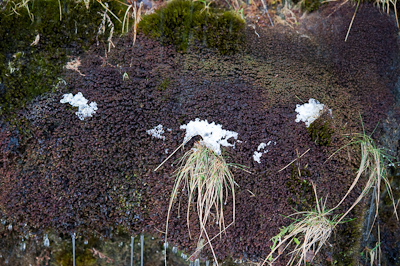
Dripping water from snowmelt saturates this large community of a crimson-coloured leafy liverwort. Growing on a metamorphic rock exposed in a cutting on the old railway line at Glen Ogle, between Lochearnhead and Killin, Stirlingshire.
Simple, thin thallus
- Blasia pusilla*
- Pellia endiviifolia
- Preissia quadrata*
- Pallavicinia lyellii
- Metzgeria fruticulosa
- Metzgeria furcata
The thalloid liverworts can be split on morphological grounds according to whether the thallus comprises a simple, thin sheet (Metzgeriidae) or having a thicker, more complex layered structure (Marchantiopsida). However, the simple thalloids are not monophyletic, but are the ancestral group from which the complex thalloids and the leafy liverworts (Jungermanniidae) arose.
The plant body of the simple thalloid liverworts is thought to resemble some of the earlier plant colonisers of the land. Clearly, a flat layer of photosynthetic cells provides a high surface area for intercepting sunlight and also ensures close contact with the substrate for moisture and nutrients.
The plant body of the simple thalloid liverworts is thought to resemble some of the earlier plant colonisers of the land. Clearly, a flat layer of photosynthetic cells provides a high surface area for intercepting sunlight and also ensures close contact with the substrate for moisture and nutrients.
Complex, thick thallus
- Conocephalum conicum*
- Conocephalum salebrosum*
- Lunularia cruciata
- Marchantia polymorpha
- Marchantia ruderale
Distinctly bifurcating
- Blasia pusilla*
- Pellia endiviifolia
- Preissia quadrata*
- Metzgeria fruticulosa
- Metzgeria furcata
-
Riccardia palmata (Q)
Note:
Both dichotomous and trichotomous-braching lobes can be found in Riccardia palmata.
Metzgeria furcata has a very thin thallus that creeps over rock and tree surfaces, portions of the thallus lobes overlapping one another as they grow towards the leading edge of the plant on its substrate.
Similar "expanding disk" growth forms are found in fungal colonies and even some mineral crystal aggregates, all characterised by incremental growth at the ends of existing flat structures, with growth more or less equal in all radial directions.
Similar "expanding disk" growth forms are found in fungal colonies and even some mineral crystal aggregates, all characterised by incremental growth at the ends of existing flat structures, with growth more or less equal in all radial directions.
Conspicuous midrib
- Marchantia polymorpha
- Metzgeria fruticulosa
- Metzgeria furcata
A number of the complex thalloid liverworts have a zone of cells lying along the central axis of the lobes, which differs in appearance from the adjacent tissues. Often this difference is noticeable as a band of differential coloration, as seen in this photo of a thallus lobe of Marchantia polymorpha.
In the simple thalloid liverwort, Metzgeria furcata (see previous image), the midrib literally stands out, as it is a number of cells in thickness while the rest of the thallus is only one cell thick. Whether this midrib is homologous with that of the complex liverworts, I don't know.
In the simple thalloid liverwort, Metzgeria furcata (see previous image), the midrib literally stands out, as it is a number of cells in thickness while the rest of the thallus is only one cell thick. Whether this midrib is homologous with that of the complex liverworts, I don't know.
Obvious air chambers
- Conocephalum conicum*
- Conocephalum salebrosum*
- Lunularia cruciata*
The complex thalloid liverworts differ from the simple thalloids in the development of layers of cells in the thallus with different roles. Conocephalum conicum has a hexagonal pattern of air chambers which contain a loose aggregate of cells specialised for photosynthesis. A central pore facilitates gas exchange while the chambers help retain moisture.
Gemmae at ends of lobes or on projecting columns
- Blasia pusilla*
- Metzgeria fruticulosa
- Metzgeria furcata
Gemmae in receptacles on thallus surface
- Conocephalum conicum*
- Conocephalum salebrosum*
- Lunularia cruciata*
The sharp-edged disk shape of the gemmae in Lunularia cruciata is shared by the gemmae of another complex thalloid liverwort, Marchantia polymorpha.
As the photo shows, gemmae can be green: they are presumably photosynthetic, and this would no doubt give a "kick-start" to each new plant developing from a gemma after dispersal.
As the photo shows, gemmae can be green: they are presumably photosynthetic, and this would no doubt give a "kick-start" to each new plant developing from a gemma after dispersal.
Large antheridiophores / archegoniophores
- Marchantia polymorpha
The antheridiophores and archegoniophores on complex thalloid liverworts such as Marchantia polymorpha are quite intricate structures, showing a high degree of differentiation of parts. This is a reminder that although liverworts were represented on Earth long before the vascular plants, it's somewhat simplistic to refer to them as "lower" plants.




